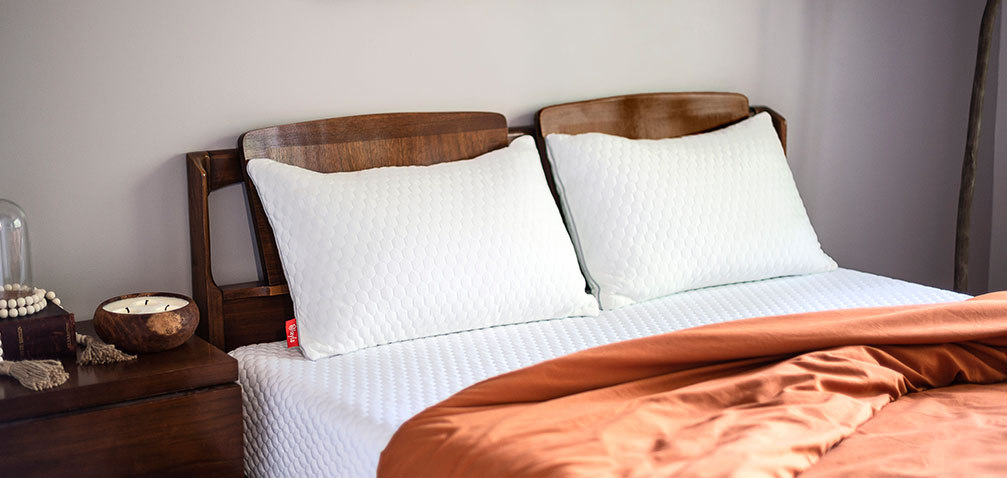- How Many Pillows Should You Sleep With at Night?
- How to Find the Right Pillow
- Sleep Peacefully With a Layla Sleep Pillow
- Wrapping Up: How Many Pillows Should You Sleep With?
How Many Pillows Should You Sleep With at Night?
Many people’s nighttime routines consist of fluffing and stacking their pillows. However, most people only need one or two pillows, but everyone has different sleep needs. Much like how much sleep you need, how many pillows you should sleep with at night varies.
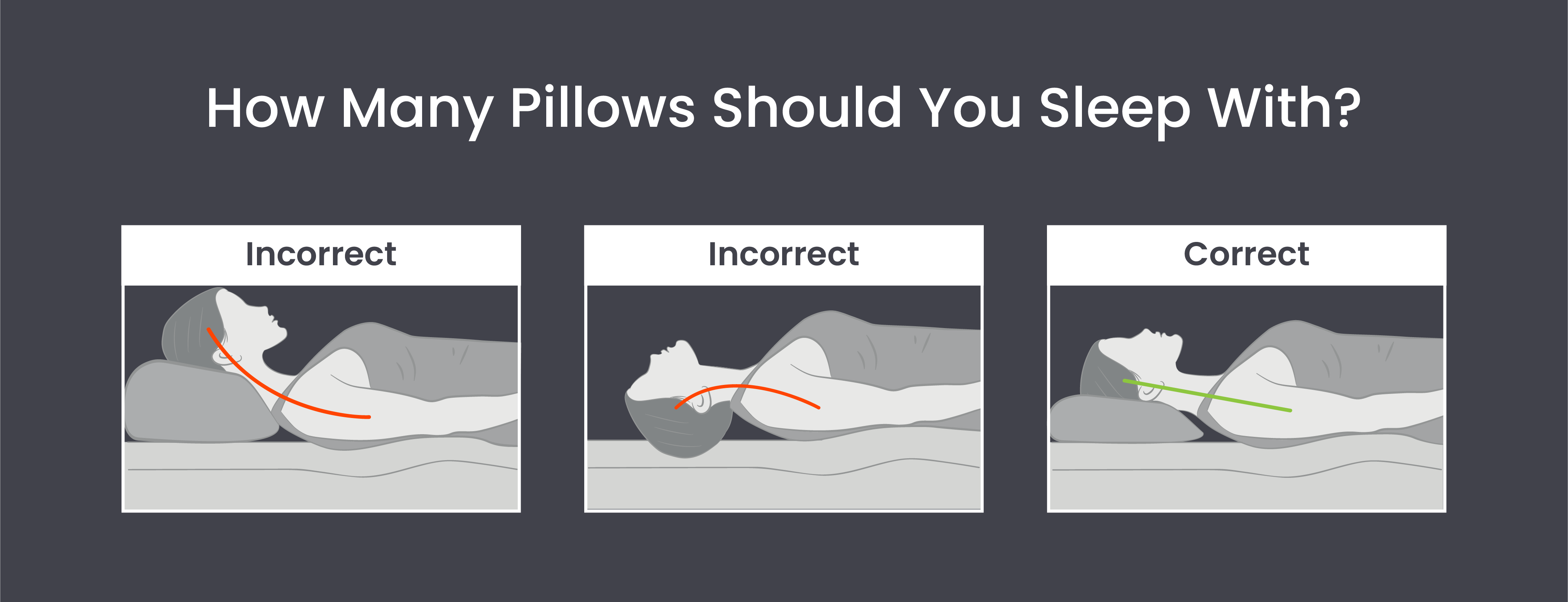
In most cases, how many pillows you need will depend on your sleep position. For example, side sleepers need at least one pillow to keep their neck in proper alignment with their shoulders, while stomach sleepers need a flat pillow or no pillow to prevent neck pain in the morning. So how many pillows should you sleep with under your head? Here are a few factors to consider:
Side Sleepers
There are several pillows available on the market designed for side sleepers. How many pillows you should sleep with as a side sleeper depends on how thick your pillows are. For example, if you have a lofty pillow, you might only need one. However, if your pillows are flat, you might need multiple. What’s more important than the number of pillows is finding a pillow or a combination that will prevent you from putting too much stress on your shoulders as you sleep.
Additionally, side sleepers may benefit from an additional pillow between their knees to relieve pressure on the lower back and hips.
Stomach Sleepers
Stomach sleepers are at a pillow disadvantage because this is considered one of the worst sleeping positions. While it can improve digestion, keeping your head, neck, back, and hips in proper alignment is near impossible. However, if you can’t change your sleeping position, consider sleeping with a single, flat pillow underneath your head. Some stomach sleepers may feel even more comfortable without a pillow.
In addition to a pillow under the head, stomach sleepers should consider adding another under their pelvis to keep their lower back and hips in proper alignment.
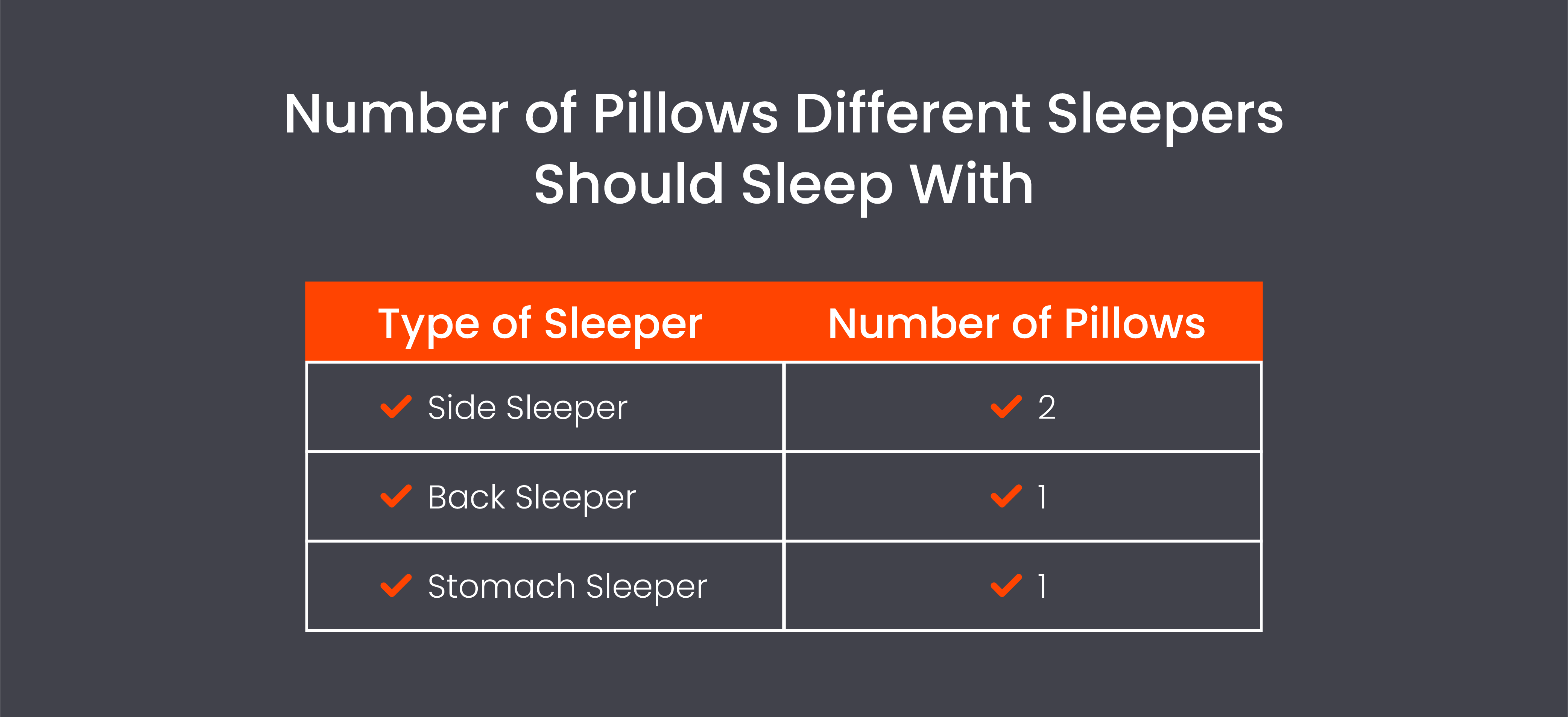
Back Sleepers
Back sleepers can usually be comfortable with one pillow as long as they keep their heads in proper alignment. Also, your pillow shouldn’t be too lofty. Sleeping on your back is the best way to keep your neck, spine, and hips in proper alignment to reduce pain.
Snorers
One downside of sleeping on your back is that back sleepers are more prone to snoring because this position relaxes the airways. However, snorers can prevent this problem and reduce the chances of waking up their spouse or partner by keeping their head elevated with an additional pillow. Of course, you should be careful not to prop your head up too much because this can force your head and neck forward, potentially causing strain. Other sleep positions don’t relax the airways as much, so if you snore, you might consider sleeping on your side instead.
Sleepers With Back Pain
If you experience back pain, your best sleeping position is either on your back or side. First, however, it’s crucial to find a pillow that keeps your body in proper alignment and possibly use one between your knees or under your body, depending on how you sink into your mattress.
If you experience regular back pain, consider strategically arranging pillows around your body depending on your sleep position. For example, if you sleep on your stomach, you can put an additional pillow under your pelvis. Meanwhile, if you sleep on your back, you can try elevating your legs by placing pillows under your knees.
How to Find the Right Pillow
Now that you have the answer to your question, “How many pillows should I sleep with?” it’s time to consider the type of pillow you use. While adding pillows can help keep your body in proper alignment, many are designed specifically based on your sleep position, so you may only need one high-quality and comfortable pillow to support your head and neck.
Unfortunately, many people don’t realize that they need a new pillow. If you’re waking up in pain, it might be obvious. However, buying a new pillow before yours starts causing problems is usually best. For example, if you notice lumps or bumps in your pillow, it may mean that, eventually, they’ll force your head out of alignment throughout the night. Additionally, if your pillow is no longer as fluffy, firm, or lofty as it once was, it’s time to get a new one before it starts causing pain. Of course, knowing how to wash pillows is crucial for preventing lumps and bumps! Still, pillows don’t last forever, so consider replacing yours every few years.
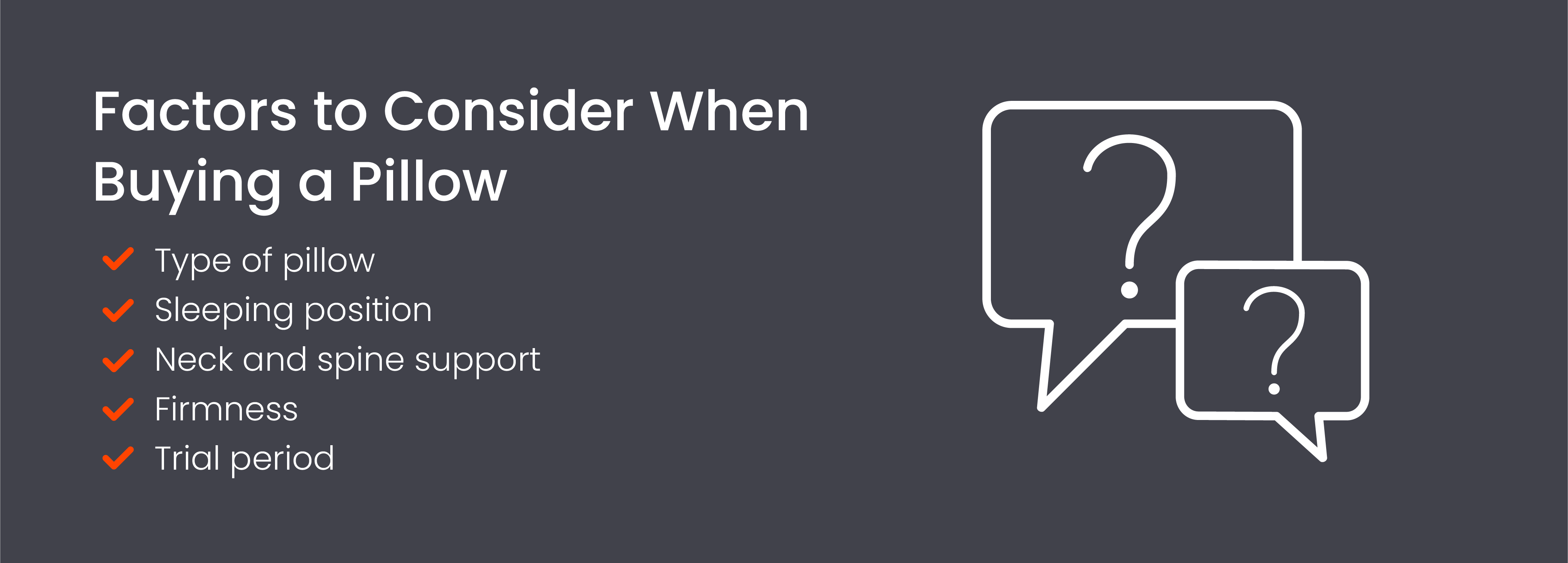
Wondering how to buy a pillow? Here are a few factors to consider when shopping for the best pillow:
- Type of pillow: The type of pillow plays a crucial role in your sleep quality and ability to keep your body in proper alignment. Consider the different materials, such as down, memory foam, polyester, and latex. Each has its pros and cons. For example, down flattens easily but is soft. Meanwhile, memory foam pillows cradle your head and neck but may be less breathable, depending on the brand.
- Sleeping position: Finding the right pillow based on your sleeping position is crucial. Side sleepers need different pillows than back sleepers in terms of firmness and height. If you’re a back sleeper, your pillow should support your neck. Many people like contoured pillows that slope in the center and support the natural curvature of their necks. Meanwhile, side sleepers should have more support from their pillow, requiring them to be higher and firmer to prevent too much pressure on the shoulders and arms.
- Neck and spine support: Your pillow should always support your neck and spine to keep it in proper alignment and prevent pain. Unfortunately, many pillows flatten easily and put your body in an uncomfortable position. For example, stomach sleepers shouldn’t sleep on a lofty, high pillow like side sleepers because it pushes their heads up and above their necks and shoulders.
- Size: Pillows come in all shapes and sizes, with the most common being standard and queen. However, you can also find a king-sized pillow designed for extra-wide mattresses. Additionally, body pillows are designed to provide full-body support and comfort, especially for side sleepers. While the size of the pillow won’t affect your body’s alignment, it can affect sleep quality. For example, using a pillow that takes up too much space can make it challenging to get comfortable at night.
- Temperature regulation: If you’re wondering how to prevent night sweats, consider your pillow. Some pillows absorb heat, which may keep your head too warm at night. If you sleep hot, consider a pillow made from breathable fabrics and materials that promote airflow to keep your head cooler.
- Firmness: Firmness also plays a crucial role in supporting your head and neck during sleep. Side sleepers need firm pillows that won’t sink in as they sleep because they could put pressure on their neck, spine, and shoulders. Meanwhile, back sleepers can look for a pillow with medium firmness that cradles the head.
- Trial period: A trial period is crucial when shopping for pillows because you won’t know if a pillow is right for you until you begin using it. Only purchase pillows from brands that allow you to try them for at least a few nights to determine if they’re right for you.
Sleep Peacefully With a Layla Sleep Pillow
Using the wrong type of pillow and the wrong number of pillows can cause back, neck, and shoulder pain while affecting your sleep quality. If it’s time for a new pillow, consider the Layla Memory Foam or Kapok Pillow, designed to provide comfort and support all night long. With Layla’s pillows, you don’t have to worry about how many you need. Instead, just one can help you get the sleep you deserve while keeping your body in proper alignment.
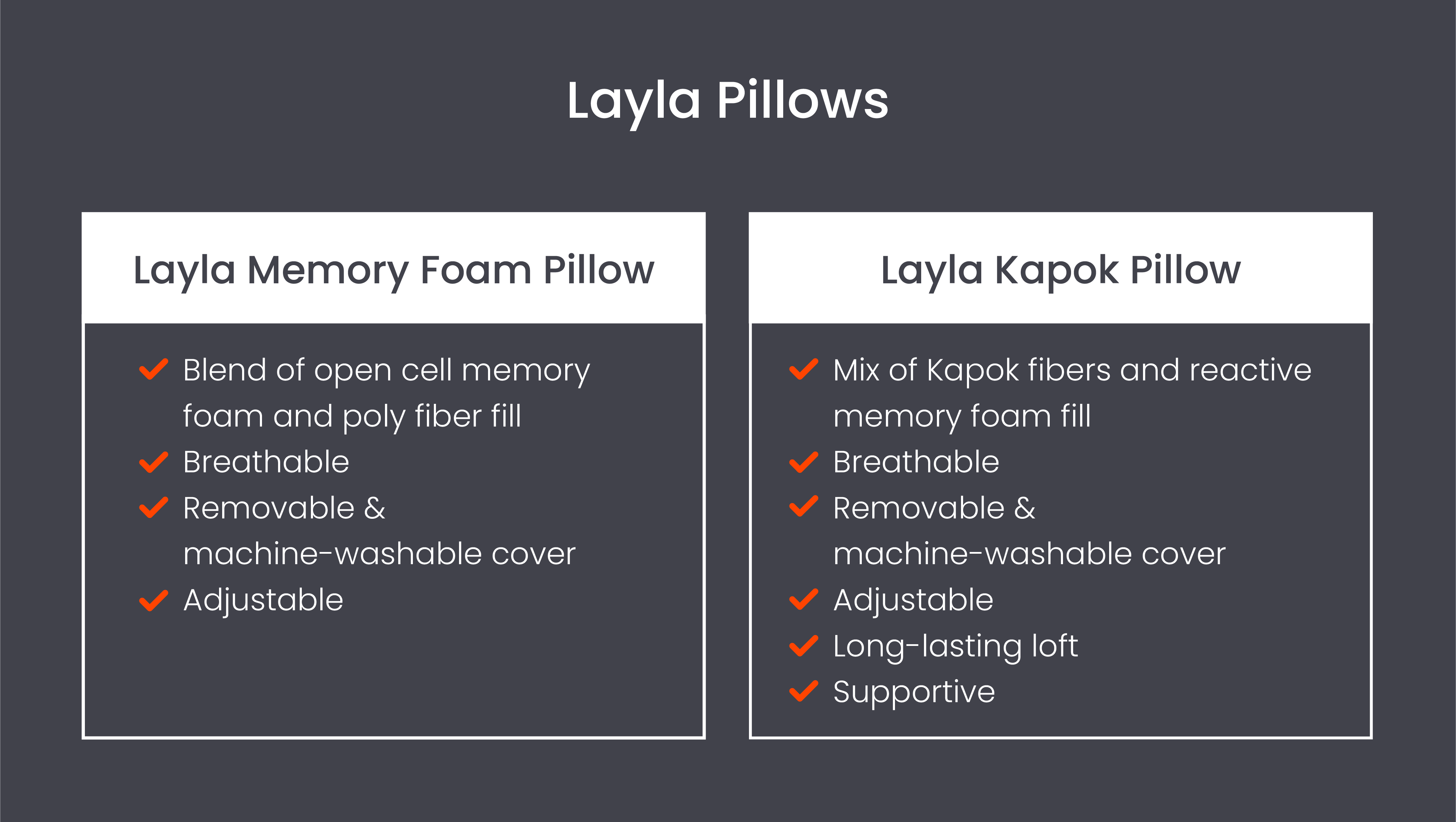
The Layla Memory Foam Pillow offers cooling support that molds to your needs—whether you’re a back, side, or stomach sleeper. It also stays cool to keep you comfortable all night long. Meanwhile, the Layla Kapok pillow is the only one you’ll ever need if you’re looking for soft support and loft. Made from reactive memory foam, this pillow molds to conform to your head and keeps its shape throughout the night. It’s also super breathable to keep you cool and comfortable.
Wrapping Up: How Many Pillows Should You Sleep With?
While the number of pillows you sleep with affects how much support your head and neck get, it’s more important to find a single pillow that’s right for you. Believe it or not, you don’t need multiple pillows; a high-quality pillow based on your sleeping position and individual preferences should be enough to prevent aches and pains from strain at night.
Additionally, don’t forget to strategically place pillows around your body for ultimate support and comfort. Adding pillows under your pelvis, between your knees, and under your legs can keep your body in proper alignment all night.
Of course, your pillows aren’t the only factor to consider for a quality night’s sleep. Learning as much as you can about sleep can help you find ways to reduce pain and improve your ability to fall asleep and stay asleep. For example, what are sleep cycles? Learning about the stages of sleep and finding new ways to improve your sleep is crucial for helping you wake up feeling refreshed and ready to tackle the day. Layla’s here to help you improve your sleep with the best products and resources. Browse our collection of mattresses, pillows, and bedding, or read more articles to learn how to improve your sleep for good.

